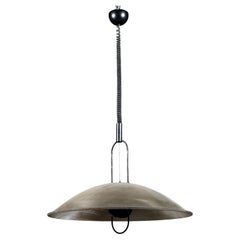Artemide Macumba
Recent Sales
Vintage 1970s Italian Mid-Century Modern Chandeliers and Pendants
Aluminum
Vintage 1970s Italian Mid-Century Modern Chandeliers and Pendants
Metal
Vintage 1970s Italian Mid-Century Modern Chandeliers and Pendants
Aluminum, Brass, Steel
Vintage 1970s Chandeliers and Pendants
Metal
Vintage 1970s Italian Mid-Century Modern Chandeliers and Pendants
Brass, Aluminum, Steel
Mid-20th Century Italian Brutalist Chandeliers and Pendants
Aluminum, Stainless Steel
Vintage 1980s Italian Brutalist Chandeliers and Pendants
Metal
Vintage 1970s Italian Mid-Century Modern Chandeliers and Pendants
Metal
Artemide for sale on 1stDibs
Artemide is an iconic firm in the design world. The mid-century Italian company is one of the best known lighting manufacturers and its award-winning fixtures are held in museum collections everywhere. Vintage Artemide table lamps, pendants, ceiling lamps and other lighting represent a thoughtful merge between functionalism and eye-catching design.
Artemide, which is based in Pregnana, was founded by Ernesto Gismondi and Sergio Mazza in 1959. During that year, Mazza created the first table lamp for the manufacturer — a modernist work in glass, marble and metal that he called the Alfa. Gismondi, who studied aeronautical engineering at the Polytechnic University of Milan and missile engineering at Rome’s Professional School of Engineering, applied his knowledge of cutting edge technology and materials such as fiberglass resin to Artemide’s designs for lighting and furniture.
In 1967, Artemide won Italy’s Compasso d'Oro design award for its Eclisse table lamp, which was designed by Vico Magistretti two years earlier. Other award-winning fixtures include the Tizio table lamp designed by Richard Sapper and the Tolomeo table lamp.
Designed by Michele de Lucchi and Giancarlo Fassina, the Tolomeo featured the patented George Carwardine mechanism used in the original Anglepoise lamp. De Lucchi would later be recruited to join visionary postmodern design collective the Memphis Group. Artemide’s Gismondi purchased the brand after founder Ettore Sottsass dismantled the collective in 1988, and it was bought by Alberto Bianchi Albrici in 1996.
Artemide’s list of design, innovation, sustainability and other industry awards is long and distinguished. The firm continues to actively collaborate with internationally revered designers and seek out new talent through workshops with design schools. The company’s deeply held values — energy-saving lighting, sustainable design and ethically sourced materials — characterize its current offerings, and Artemide furniture and lighting can be found in the permanent collections of the Metropolitan Museum of Art, the Museum of Modern Art and other institutions.
On 1stDibs, find Artemide tables, seating, floor lamps, chandeliers and more.
Finding the Right chandeliers-pendant-lights for You
Chandeliers — simple in form, inspired by candelabras and originally made of wood or iron — first made an appearance in early churches. For those wealthy enough to afford them for their homes in the medieval period, a chandelier's suspended lights likely exuded imminent danger, as lit candles served as the light source for fixtures of the era. Things have thankfully changed since then, and antique and vintage chandeliers and pendant lights are popular in many interiors today.
While gas lighting during the late 18th century represented an upgrade for chandeliers — and gas lamps would long inspire Danish architect and pioneering modernist lighting designer Poul Henningsen — it would eventually be replaced with the familiar electric lighting of today.
The key difference between a pendant light and a chandelier is that a pendant incorporates only a single bulb into its design. Don’t mistake this for simplicity, however. An Art Deco–styled homage to Sputnik from Murano glass artisans Giovanni Dalla Fina (note: there is more than one lighting fixture that shares its name with the iconic mid-century-era satellite — see Gino Sarfatti’s design too), with handcrafted decorative elements supported by a chrome frame, is just one stunning example of the elaborate engineering that can be incorporated into every component of a chandelier.
Chandeliers have evolved over time, but their classic elegance has remained unchanged. Not only will the right chandelier prove impressive in a given room, but it can also offer a certain sense of practicality. These fixtures can easily illuminate an entire space, while their elevated position prevents them from creating glare or straining one’s eyes. Certain materials, like glass, can complement naturally lit settings without stealing the show. Brass, on the other hand, can introduce an alluring, warm glow. While LEDs have earned a bad reputation for their perceived harsh bluish lights and a loss of brightness over their life span, the right design choices can help harness their lighting potential and create the perfect mood. A careful approach to lighting can transform your room into a peaceful and cozy nook, ideal for napping, reading or working.
For midsize spaces, a wall light or sconce can pull the room together and get the lighting job done. Perforated steel rings underneath five bands of handspun aluminum support a rich diffusion of light within Alvar Aalto's Beehive pendant light, but if you’re looking to brighten a more modest room, perhaps a minimalist solution is what you’re after. The mid-century modern furniture designer Charlotte Perriand devised her CP-1 wall lamps in the 1960s, in which a repositioning of sheet-metal plates can redirect light as needed.
The versatility and variability of these lighting staples mean that, when it comes to finding something like the perfect chandelier, you’ll never be left hanging. From the whimsical — like the work of Beau & Bien’s Sylvie Maréchal, frequently inspired by her dreams — to the classic beauty of Paul Ferrante's fixtures, there is a style for every room. With designs for pendant lights and chandeliers across eras, colors and materials, you’ll never run out of options to explore on 1stDibs.

